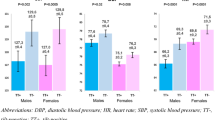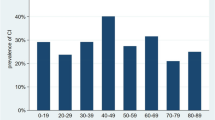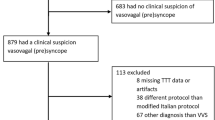Abstract
Introduction
Patients with vasovagal syncope (VVS) and positive tilt table test (TTT) were not found to benefit from pacing in the ISSUE-3 trial despite the presence of spontaneous asystole during monitoring. “Hypotensive susceptibility” unmasked by TTT was reported as a possible explanation. The purpose of this study was to assess the pathophysiologic mechanisms associated with hypotensive susceptibility.
Methods
366 consecutive patients with the diagnosis of VVS who also had TTT were identified. Baroreflex gain (BRG) in addition to blood pressure (BP) and heart rate (HR) responses during the first 20 min of TTT were analyzed and compared between patients with positive TTT (n = 275, 75 %) and negative TTT (n = 91, 25 %).
Results
The mean BRG was similar between the groups (12.5 ± 6.3 versus 12.4 ± 6.3 ms/mmHg, p = 0.72); however, an age-dependent decrease was noted (17.6 ± 4.8, 15.0 ± 6.0, 10.6 ± 4.2, 10.3 ± 6.4 and 9.9 ± 8.5 ms/mmHg for patients <21, 21–40, 41–60, 61–80 and >80 years old, respectively; p < 0.001). In addition, we saw a main effect of age on the type of response with a greater prevalence of a vasodepressor response in older subjects (p < 0.001). During the first 20 min of TTT, BP was similar in patients with tilt-positive VVS when compared with patients with tilt-negative VVS; however, HR was significantly lower.
Conclusion
BRG is similar in tilt-positive VVS patients when compared with tilt-negative VVS patients. An age-dependent decrease in BRG was noted with a higher prevalence of a vasodepressor response seen in older patients. The clinical significance of the blunted HR response in tilt-positive VVS remains to be determined.




Similar content being viewed by others
Abbreviations
- BP:
-
Blood pressure
- BRG:
-
Baroreflex gain
- DBP:
-
Diastolic blood pressure
- EF:
-
Ejection fraction
- HR:
-
Heart rate
- MBP:
-
Mean blood pressure
- SBP:
-
Systolic blood pressure
- TTT:
-
Tilt table test
- VVS:
-
Vasovagal syncope
References
Moya A, Sutton R, Ammirati F, Blanc JJ, Brignole M, Dahm JB, Deharo JC, Gajek J, Gjesdal K, Krahn A, Massin M, Pepi M, Pezawas T, Ruiz Granell R, Sarasin F, Ungar A, van Dijk JG, Walma EP, Wieling W, Task Force for the D, Management of S, European Society of C, European Heart Rhythm A, Heart Failure A, Heart Rhythm S (2009) Guidelines for the diagnosis and management of syncope (version 2009). Eur Heart J 30(21):2631–2671. doi:10.1093/eurheartj/ehp298
Kenny RA, Ingram A, Bayliss J, Sutton R (1986) Head-up tilt: a useful test for investigating unexplained syncope. Lancet 1(8494):1352–1355
Flevari P, Leftheriotis D, Komborozos C, Fountoulaki K, Dagres N, Theodorakis G, Kremastinos D (2009) Recurrent vasovagal syncope: comparison between clomipramine and nitroglycerin as drug challenges during head-up tilt testing. Eur Heart J 30(18):2249–2253. doi:10.1093/eurheartj/ehp255
Furukawa T, Maggi R, Solano A, Croci F, Brignole M (2011) Effect of clinical triggers on positive responses to tilt-table testing potentiated with nitroglycerin or clomipramine. Am J Cardiol 107(11):1693–1697. doi:10.1016/j.amjcard.2011.01.057
Petix NR, Del Rosso A, Furlan R, Guarnaccia V, Zipoli A (2014) Nitrate-potentiated head-up tilt testing (HUT) has a low diagnostic yield in patients with likely vasovagal syncope. Pacing Clin Electrophysiol 37(2):164–172. doi:10.1111/pace.12235
Raviele A, Menozzi C, Brignole M, Gasparini G, Alboni P, Musso G, Lolli G, Oddone D, Dinelli M, Mureddu R (1995) Value of head-up tilt testing potentiated with sublingual nitroglycerin to assess the origin of unexplained syncope. Am J Cardiol 76(4):267–272
Brignole M, Menozzi C, Moya A, Andresen D, Blanc JJ, Krahn AD, Wieling W, Beiras X, Deharo JC, Russo V, Tomaino M, Sutton R, International Study on Syncope of Uncertain Etiology I (2012) Pacemaker therapy in patients with neurally mediated syncope and documented asystole: Third International Study on Syncope of Uncertain Etiology (ISSUE-3): a randomized trial. Circulation 125(21):2566–2571. doi:10.1161/CIRCULATIONAHA.111.082313
Brignole M, Donateo P, Tomaino M, Massa R, Iori M, Beiras X, Moya A, Kus T, Deharo JC, Giuli S, Gentili A, Sutton R, International Study on Syncope of Uncertain Etiology I (2014) Benefit of pacemaker therapy in patients with presumed neurally mediated syncope and documented asystole is greater when tilt test is negative: an analysis from the third International Study on Syncope of Uncertain Etiology (ISSUE-3). Circ Arrhythm Electrophysiol 7(1):10–16. doi:10.1161/CIRCEP.113.001103
Sutton R, Brignole M (2014) Twenty-eight years of research permit reinterpretation of tilt-testing: hypotensive susceptibility rather than diagnosis. Eur Heart J 35(33):2211–2212. doi:10.1093/eurheartj/ehu255
Sheldon RS, Grubb BP 2nd, Olshansky B, Shen WK, Calkins H, Brignole M, Raj SR, Krahn AD, Morillo CA, Stewart JM, Sutton R, Sandroni P, Friday KJ, Hachul DT, Cohen MI, Lau DH, Mayuga KA, Moak JP, Sandhu RK, Kanjwal K (2015) 2015 heart rhythm society expert consensus statement on the diagnosis and treatment of postural tachycardia syndrome, inappropriate sinus tachycardia, and vasovagal syncope. Heart Rhythm 12(6):e41–e63. doi:10.1016/j.hrthm.2015.03.029
Brignole M, Menozzi C, Del Rosso A, Costa S, Gaggioli G, Bottoni N, Bartoli P, Sutton R (2000) New classification of haemodynamics of vasovagal syncope: beyond the VASIS classification. Analysis of the pre-syncopal phase of the tilt test without and with nitroglycerin challenge. Vasovagal Syncope International Study. Europace 2(1):66–76
Hughson RL, Quintin L, Annat G, Yamamoto Y, Gharib C (1993) Spontaneous baroreflex by sequence and power spectral methods in humans. Clin Physiol 13(6):663–676
Borst C, Wieling W, van Brederode JF, Hond A, de Rijk LG, Dunning AJ (1982) Mechanisms of initial heart rate response to postural change. Am J Physiol 243(5):H676–H681
Dambrink JH, Wieling W (1987) Circulatory response to postural change in healthy male subjects in relation to age. Clin Sci (Lond) 72(3):335–341
Petersen ME, Williams TR, Gordon C, Chamberlain-Webber R, Sutton R (2000) The normal response to prolonged passive head up tilt testing. Heart 84(5):509–514
Borst C, Meijler FL (1984) Baroreflex modulation of ventricular rhythm in atrial fibrillation. Eur Heart J 5(11):870–875
Barcroft H, Edholm OG (1945) On the vasodilatation in human skeletal muscle during post-haemorrhagic fainting. J Physiol 104(2):161–175
Epstein SE, Stampfer M, Beiser GD (1968) Role of the capacitance and resistance vessels in vasovagal syncope. Circulation 37(4):524–533
Morillo CA, Eckberg DL, Ellenbogen KA, Beightol LA, Hoag JB, Tahvanainen KU, Kuusela TA, Diedrich AM (1997) Vagal and sympathetic mechanisms in patients with orthostatic vasovagal syncope. Circulation 96(8):2509–2513
Mosqueda-Garcia R, Furlan R, Fernandez-Violante R, Desai T, Snell M, Jarai Z, Ananthram V, Robertson RM, Robertson D (1997) Sympathetic and baroreceptor reflex function in neurally mediated syncope evoked by tilt. J Clin Invest 99(11):2736–2744
Sharpey-Schafer EP (1956) Syncope. Br Med J 1(4965):506–509
Wallin BG, Sundlof G (1982) Sympathetic outflow to muscles during vasovagal syncope. J Auton Nerv Syst 6(3):287–291
Moya A, Brignole M, Menozzi C, Garcia-Civera R, Tognarini S, Mont L, Botto G, Giada F, Cornacchia D, International Study on Syncope of Uncertain Etiology I (2001) Mechanism of syncope in patients with isolated syncope and in patients with tilt-positive syncope. Circulation 104(11):1261–1267
Cooke WH, Rickards CA, Ryan KL, Kuusela TA, Convertino VA (2009) Muscle sympathetic nerve activity during intense lower body negative pressure to presyncope in humans. J Physiol 587(Pt 20):4987–4999. doi:10.1113/jphysiol.2009.177352
Fu Q, Verheyden B, Wieling W, Levine BD (2012) Cardiac output and sympathetic vasoconstrictor responses during upright tilt to presyncope in healthy humans. J Physiol 590(Pt 8):1839–1848. doi:10.1113/jphysiol.2011.224998
Vaddadi G, Esler MD, Dawood T, Lambert E (2010) Persistence of muscle sympathetic nerve activity during vasovagal syncope. Eur Heart J 31(16):2027–2033. doi:10.1093/eurheartj/ehq071
Jardine DL, Melton IC, Crozier IG, English S, Bennett SI, Frampton CM, Ikram H (2002) Decrease in cardiac output and muscle sympathetic activity during vasovagal syncope. Am J Physiol Heart Circ Physiol 282(5):H1804–H1809. doi:10.1152/ajpheart.00640.2001
Verheyden B, Liu J, van Dijk N, Westerhof BE, Reybrouck T, Aubert AE, Wieling W (2008) Steep fall in cardiac output is main determinant of hypotension during drug-free and nitroglycerine-induced orthostatic vasovagal syncope. Heart Rhythm 5(12):1695–1701. doi:10.1016/j.hrthm.2008.09.003
Brignole M, Ammirati F, Arabia F, Quartieri F, Tomaino M, Ungar A, Lunati M, Russo V, Del Rosso A, Gaggioli G, Syncope Unit Project Two I (2015) Assessment of a standardized algorithm for cardiac pacing in older patients affected by severe unpredictable reflex syncopes. Eur Heart J 36(24):1529–1535. doi:10.1093/eurheartj/ehv069
Shinohara T, Ebata Y, Ayabe R, Fukui A, Okada N, Yufu K, Nakagawa M, Takahashi N (2014) Cardiac autonomic dysfunction in patients with head-up tilt test-induced vasovagal syncope. Pacing Clin Electrophysiol 37(12):1694–1701. doi:10.1111/pace.12484
Klemenc M, Strumbelj E (2015) Predicting the outcome of head-up tilt test using heart rate variability and baroreflex sensitivity parameters in patients with vasovagal syncope. Clin Auton Res 25(6):391–398. doi:10.1007/s10286-015-0318-6
Ebert TJ, Morgan BJ, Barney JA, Denahan T, Smith JJ (1992) Effects of aging on baroreflex regulation of sympathetic activity in humans. Am J Physiol 263(3 Pt 2):H798–H803
Monahan KD (2007) Effect of aging on baroreflex function in humans. Am J Physiol Regul Integr Comp Physiol 293(1):R3–R12. doi:10.1152/ajpregu.00031.2007
Greene NM, Bachand RG (1971) Vagal component of the chronotropic response to baroreceptor stimulation in man. Am Heart J 82(1):22–27
Gribbin B, Pickering TG, Sleight P, Peto R (1971) Effect of age and high blood pressure on baroreflex sensitivity in man. Circ Res 29(4):424–431
Kardos A, Watterich G, de Menezes R, Csanady M, Casadei B, Rudas L (2001) Determinants of spontaneous baroreflex sensitivity in a healthy working population. Hypertension 37(3):911–916
Kurbaan AS, Bowker TJ, Wijesekera N, Franzen AC, Heaven D, Itty S, Sutton R (2003) Age and hemodynamic responses to tilt testing in those with syncope of unknown origin. J Am Coll Cardiol 41(6):1004–1007
Theodorakis GN, Kremastinos DT, Avrambos GT, Stefanakis GS, Karavolias GK, Toutouzas PK (1992) Heart rate variability in patients with vasovagal syndrome. Pacing Clin Electrophysiol 15(11 Pt 2):2221–2225
Hausenloy DJ, Arhi C, Chandra N, Franzen-McManus AC, Meyer A, Sutton R (2009) Blood pressure oscillations during tilt testing as a predictive marker of vasovagal syncope. Europace 11(12):1696–1701. doi:10.1093/europace/eup338
Folino AF, Migliore F, Marinelli A, Iliceto S, Buja G (2010) Age-related hemodynamic changes during vasovagal syncope. Auton Neurosci 156(1–2):131–137. doi:10.1016/j.autneu.2010.04.009
Acknowledgments
This work was supported in part by funds provided from the Mildred and Marv Conney Chair in Cardiology.
Author information
Authors and Affiliations
Corresponding author
Ethics declarations
Conflict of interest
None.
Rights and permissions
About this article
Cite this article
Chaddha, A., Rafanelli, M., Brignole, M. et al. The pathophysiologic mechanisms associated with hypotensive susceptibility. Clin Auton Res 26, 261–268 (2016). https://doi.org/10.1007/s10286-016-0362-x
Received:
Accepted:
Published:
Issue Date:
DOI: https://doi.org/10.1007/s10286-016-0362-x




